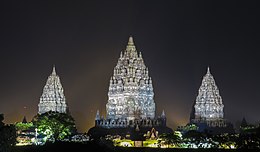တြိမူတိ
ထာမ်ပလိက်:Infobox deity တြိမူတိ (Trimūrti (/trɪˈmʊərti/; Sanskrit: त्रिमूर्ति trimūrti, "three forms") ဂှ် ဒှ်ဘာသာ မရှ်ေသှ်ေ ကျာ်ကိစ္စဇၞော်အိုတ် ပိဇကု ပ္ဍဲကဵု ဟိန္ဒူ[၁][၂][၃][၄] မဒှ် ကျာ်ပဒှ်၊ ကျာ်ပၟင်ပၟဲ ကေုာံ ကျာ်ပလီု နဒဒှ် ပိဇကု မဒှ်မွဲတၠရ။ ကျာ်ပိဇကုဂှ် သၟိင်ဗြီု မဒှ် ညးမပဒှ်၊ ဗိသၞုဟ် မဒှ်ညးမမင်မဲ တုဲ သဳဝ မဒှ်ညးမပလီု၊ ညးပိဝွံ ညးတအ်ပတှ်ေကေတ် မဒှ်မွဲတၞောဝ် မွဲဇကုရ။ ညးတအ် ပတှ်ေကေတ် ကျာ်ပိဇကုဝွံ မဒှ်မွဲဇကု က္ဍိုပ်ပိရ။[၅]
Evolution
[ပလေဝ်ဒါန် | ပလေဝ်ဒါန် တမ်ကၞက်]-
တြိမူတိ နကဵု တြိဒေဝ
-
ပေါန်ကွတ် မဗၟံက်ထ္ၜးလဝ် တြိမူတိ ပ္ဍဲကဵု ဘာဟောသလေသွာရ (Hoysaleswara temple) ပ္ဍဲ ဟလေဗိဒု (Halebidu)
-
တြိမူတိ၊ ပါန်သူ နူကဵု အန္ဓရာပြဒေသ် (Andhra Pradesh)
The Puranic period saw the rise of post-Vedic religion and the evolution of what R. C. Majumdar calls "synthetic Hinduism". This period had no homogeneity, and included orthodox Brahmanism in the form of remnants of older Vedic faith traditions, along with different sectarian religions, notably Shaivism, Vaishnavism, and Shaktism that were within the orthodox fold yet still formed distinct entities. One of the important traits of this period is a spirit of harmony between orthodox and sectarian forms. Regarding this spirit of reconciliation, R. C. Majumdar says that:
Its most notable expression is to be found in the theological conception of the Trimūrti, i.e., the manifestation of the supreme God in three forms of Brahmā, Viṣṇu, and Śiva... But the attempt cannot be regarded as a great success, for Brahmā never gained an ascendancy comparable to that of Śiva or Viṣṇu, and the different sects often conceived the Trimūrti as really the three manifestations of their own sectarian god, whom they regarded as Brahman or Absolute.
However, this argument overlooks the obvious correlation of Brahmā with Brahman. The identification of Brahma, Vishnu, and Shiva as one being is strongly emphasized in the Kūrma Purāṇa, wherein 1.6 Brahman is worshipped as Trimurti; 1.9 especially inculcates the unity of the three gods, and 1.26 relates to the same theme.[၆] Historian A. L. Basham explains the background of the Trimurti as follows, nothing,Western interest in the idea of trinity:
There must be some doubt as to whether the Hindu tradition has ever recognized Brahma as the Supreme Deity in the way that Visnu and Siva have been conceived of and worshiped.[၇]
The concept of Trimurti is also present in the Maitri Upanishad, where the three gods are explained as three of his supreme forms.
ဘာတြိမူတဳ
[ပလေဝ်ဒါန် | ပလေဝ်ဒါန် တမ်ကၞက်]
Temples dedicated to various permutations of the Trimurti can be seen as early as the 6th century C.E., and there are still some temples today in which the Trimurti are actively worshiped.
- Baroli Trimurti Temple
- Elephanta Caves
- Mithrananthapuram Trimurti Temple
- Prambanan Trimurti Temple
- Savadi Trimurti Temple
- Thripaya Trimurti Temple
Views within Hinduism
[ပလေဝ်ဒါန် | ပလေဝ်ဒါန် တမ်ကၞက်]In general it can be said that the trimurti has less of a role in the Hinduism of recent centuries than in ancient India.
Citations
[ပလေဝ်ဒါန် | ပလေဝ်ဒါန် တမ်ကၞက်]- ↑ Ganapati: Song of the Self။
- ↑ The Book of Hindu Imagery။
- ↑ The Cultural Heritage of India။
- ↑ History of Indian Literature။
- ↑ Datta Sampradaay and Their Vital Role. Archived from the original on 4 March 2016။
- ↑ For references to Kūrma Purana see: Winternitz, volume 1, p. 573, note 2.
- ↑ Religious doctrines in the Mahābhārata။
General sources
[ပလေဝ်ဒါန် | ပလေဝ်ဒါန် တမ်ကၞက်]- Basham, A. L. (1954). The Wonder That Was India: A Survey of the Culture of the Indian Sub-Continent Before the Coming of the Muslims. New York: Grove Press။
- Courtright, Paul B. (1985). Gaṇeśa: Lord of Obstacles, Lord of Beginnings. New York: Oxford University Press။
- Flood, Gavin (1996). An Introduction to Hinduism. Cambridge: Cambridge University Press။
- (2003) The Blackwell Companion to Hinduism. Malden, MA: Blackwell Publishing။
- Zimmer, Heinrich (1972). Myths and Symbols in Indian Art and Civilization. Princeton, New Jersey: Princeton University Press။



